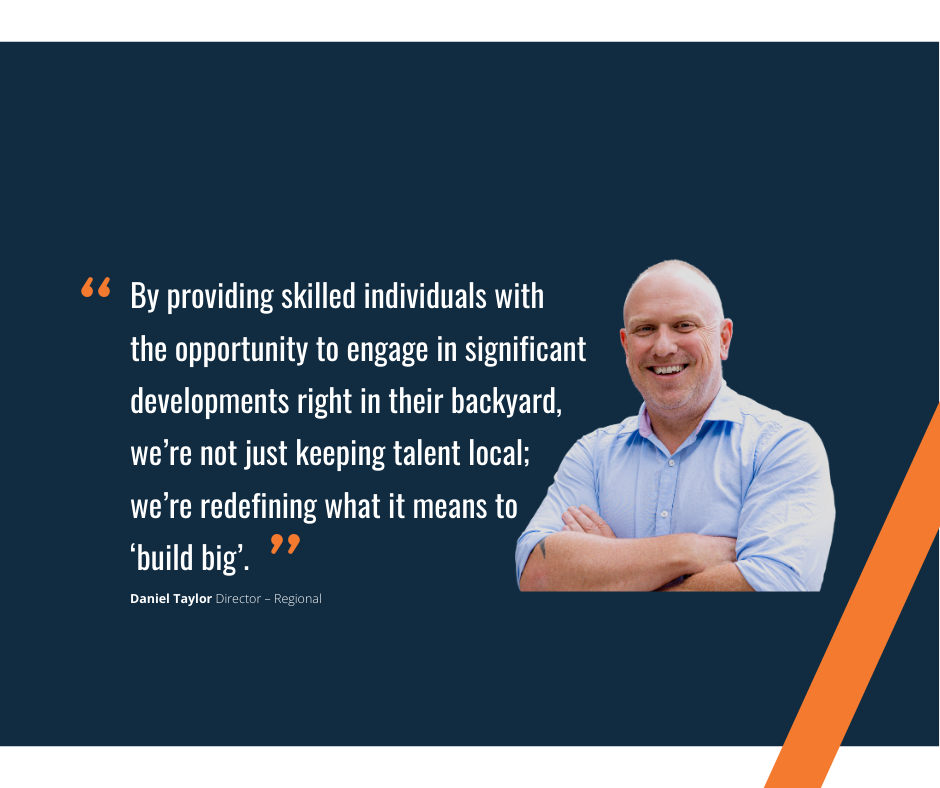
As comunidades regionais e rurais da Austrália há muito enfrentam desafios decorrentes da divisão entre áreas urbanas e rurais, com acesso limitado a serviços e oportunidades comumente encontrados nas grandes cidades.
No entanto, uma transformação significativa está em andamento, com foco no desenvolvimento de infraestrutura para fechar essa lacuna e estimular o crescimento econômico nessas áreas cruciais. Essa mudança inclui melhorias em redes de transporte, projetos de energia renovável, infraestrutura hídrica e conectividade digital.
Daniel Taylor, Diretor - Regional, CaSE Civil & Structural Engineering, lança luz sobre as estratégias e inovações que impulsionam o futuro da Austrália rural e regional. Taylor enfatiza que esses projetos de infraestrutura melhorarão significativamente a qualidade de vida nessas regiões, desbloqueando novas oportunidades para comunidades que muitas vezes foram negligenciadas.
Essa mudança impulsionada pela infraestrutura marca o início de uma nova era para a Austrália regional, oferecendo serviços e possibilidades que antes eram exclusivos dos centros urbanos. A iniciativa representa um compromisso nacional para revitalizar áreas regionais, garantindo que cada comunidade possa prosperar.
A melhoria das redes de transporte cria linhas de vida de conectividade
A expansão e a melhoria das redes de transporte são essenciais para os esforços da Austrália para reduzir a divisão. Conexões rodoviárias, ferroviárias e aéreas aprimoradas são mais do que apenas conveniências; elas são vitais para integrar a Austrália regional à comunidade nacional e global. O relatório Infrastructure Market Capacity de 2023 da Infrastructure Australia destaca o nível sem precedentes de investimento fluindo para áreas regionais, particularmente em Nova Gales do Sul, Austrália do Sul e Queensland.
De acordo com o relatório, algumas regiões devem ver um aumento anual de 75% em investimentos em infraestrutura, com certas áreas experimentando uma duplicação do investimento em um ano. Esse aumento significativo na atividade de construção fala do imenso potencial dos projetos de infraestrutura em moldar o futuro da Austrália. Zonas de Energia Renovável (REZs) como a New England REZ e iniciativas transformadoras como a Inland Rail são projetadas para servir como catalisadores econômicos, criando empregos e fomentando o crescimento econômico em comunidades regionais.
Sublinhando a importância destes desenvolvimentos;
“Esses projetos não são apenas sobre construção; eles representam uma mudança fundamental em direção ao fortalecimento de nossas comunidades regionais. Estamos criando oportunidades para profissionais qualificados contribuírem para projetos locais significativos, redefinindo o que significa 'construir grande'. Esta iniciativa desafia a atração tradicional em direção aos centros urbanos, promovendo o crescimento sustentável em áreas regionais.”
Daniel Taylor
Ao investir em infraestrutura de transporte, a Austrália não está apenas construindo comunidades mais conectadas, mas também reforçando seu compromisso com o desenvolvimento sustentável. A conectividade melhorada abrirá portas para empresas locais, agricultura e turismo, permitindo que a Austrália regional contribua de forma mais significativa para a resiliência econômica nacional.
Um dos aspectos mais transformadores do desenvolvimento regional está no aprimoramento da conectividade digital. Serviços de banda larga e internet móvel atuam como portais para serviços essenciais como educação, saúde e oportunidades de negócios. O Better Connectivity Plan do governo australiano, que aloca mais de $1,1 bilhão para melhorar as telecomunicações em áreas rurais e regionais, reflete o poder transformador da infraestrutura digital.
Taylor destaca o quão crítica a conectividade digital é para projetos de infraestrutura modernos: “A conectividade digital permite tecnologias avançadas como drones para levantamento topográfico e análise de dados em tempo real para supervisão de projetos em larga escala. Serviços de internet robustos são essenciais para integrar essas inovações em operações diárias, impulsionando eficiência e desenvolvimento mais inteligente na Austrália regional.”
Essa conectividade é crucial para diminuir a lacuna entre os cenários urbanos e rurais, tornando o desenvolvimento de infraestrutura mais inclusivo e eficiente. O acesso digital aprimorado capacitará as comunidades regionais a inovar, atrair investimentos e participar da economia global.
O envolvimento da comunidade é essencial para garantir que os projetos de infraestrutura atendam às necessidades reais da Austrália regional. O Primeiro Ministro Anthony Albanese, em seu discurso recente no Queensland Media Club, enfatizou a importância de envolver todas as comunidades na formação do futuro da nação. Para que o desenvolvimento de infraestrutura seja realmente eficaz, as vozes locais devem ser ouvidas nos processos de planejamento e tomada de decisão.
Taylor ecoa esse sentimento, enfatizando que o engajamento da comunidade é essencial para projetos de infraestrutura bem-sucedidos. “Não se trata apenas de consulta; trata-se de colaboração. Ao envolver comunidades locais, criar empregos e incorporar a herança cultural em nossos projetos, estamos construindo mais do que infraestrutura — estamos promovendo regiões mais fortes e unificadas”, ele diz.
Essa abordagem colaborativa garante que os projetos de infraestrutura não sejam apenas fisicamente transformadores, mas também social e culturalmente significativos, melhorando a identidade e a coesão da comunidade.
Embora o futuro da Austrália regional pareça promissor, a escassez de mão de obra representa um grande desafio. O relatório de 2023 da Infrastructure Australia destaca a necessidade crítica de mão de obra qualificada, particularmente em setores cruciais para o desenvolvimento de infraestrutura. A escassez de engenheiros, comerciantes e trabalhadores representa riscos para a entrega oportuna e econômica desses projetos.
Taylor traz uma nova perspectiva para essa questão, focando em atrair talentos profissionais para áreas regionais. “Para garantir um crescimento sustentável, a Austrália regional deve atrair casais profissionais”, ele afirma, observando que criar oportunidades de emprego para conjuntos de habilidades diversos é crucial para reter talentos nessas áreas.
Lidar com esses desafios da força de trabalho exigirá uma estratégia nacional de infraestrutura de força de trabalho que se concentre em educação, treinamento e incentivos para manter talentos na Austrália regional. Ao fazer isso, as comunidades regionais podem continuar a se beneficiar de investimentos em infraestrutura e construir resiliência para o futuro.
O investimento da Austrália em infraestrutura está preparando o terreno para um futuro mais conectado e inclusivo. Ao focar em transporte, energia renovável, conectividade digital e infraestrutura hídrica, o país está trabalhando para estreitar a divisão urbano-rural e criar uma nação mais equilibrada e resiliente. À medida que essas iniciativas continuam a se desenvolver, elas prometem transformar áreas regionais em comunidades prósperas, levando a Austrália a um futuro próspero e unido.

Vanessa é uma experiente consultora de marketing, desenvolvimento de negócios e estratégia, apaixonada por compartilhar as complexidades da engenhosidade da engenharia civil e estrutural por meio de um estilo de contar histórias que estimula o envolvimento e estimula um aprendizado mais profundo.